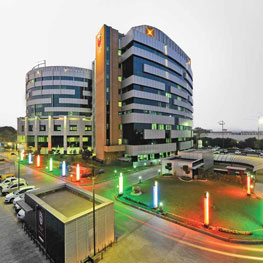About the Doctor
Dr. Vishal Saxena is a leading name in the field of nephrology & renal transplantation. He has been widely acknowledged for his versatile and patient-centric approach
Specialization
- Nephrology & Renal Transplantation
Awards
- Best Paper Presentation at APICON Jaipur – 2000
- Best Paper Presentation at Indraprastha Apollo Hospitals – 2005
- Star Docto of the month –Fortis Hospital – Vasant kunj
- Gold Medal – University Precaution – An answer to preventing HCV Transmission in HD units – V Saxena, S Gulati, V Kher – Fortis Hospitals-ISN 2009, Guwahati
- ,2020
Frequently Asked Questions About Nephrology
What is Dialysis?
In medicine, dialysis is a process for removing waste and excess water from the blood, and is used primarily to provide an artificial replacement for lost kidney function in people with renal failure. Dialysis may be used for those with an acute disturbance in kidney function (acute kidney injury, previously acute renal failure), or progressive but chronically worsening kidney function–a state known as chronic kidney disease stage 5 (previously chronic renal failure or end-stage renal disease). The latter form may develop over months or years, but in contrast to acute kidney injury is not usually reversible, and dialysis is regarded as a “holding measure” until a renal transplant can be performed, or sometimes as the only supportive measure in those for whom a transplant would be inappropriate.
The kidneys have important roles in maintaining health. When healthy, the kidneys maintain the body’s internal equilibrium of water and minerals (sodium, potassium, chloride, calcium, phosphorus, magnesium, sulfate). Those acidic metabolism end-products that the body cannot get rid of via respiration are also excreted through the kidneys. The kidneys also function as a part of the endocrine system, producing erythropoietin and calcitriol. Erythropoietin is involved in the production of red blood cells and calcitriol plays a role in bone formation. Dialysis is an imperfect treatment to replace kidney function because it does not correct the endocrine functions of the kidney. Dialysis treatments replace some of these functions through diffusion (waste removal) and ultrafiltration (fluid removal).
What is Renal Calculus?
Renal stone or calculus or lithiasis is one of the most common diseases of the urinary tract. It occurs more frequently in men than in women.. It shows a familial predisposition.
Urinary calculus is a stone-like body composed of urinary salts bound together by a colloid matrix of organic materials. It consists of a nucleus around which concentric layers of urinary salts are deposited.
Clinical Features
Symptoms
- Quiescent calculus
- Pain
- Fixed renal pain
- Ureteric colic
- Referred pain
- Hydronephrosis (a lump in the loin and a dull ache)
- Haematuria(blood in urine)
- Pyuria (pus in urine)
Physical Signs
- Tenderness at the ‘renal angle’ posteriorly.
- Muscle rigidity over the kidney
- Swelling in the flank when there is hydronephrosis or pyonephrosis associated with renal calculus.
- Abdominal distension and diminished peristalsis may accompany ureteric colic.
When a stone causes no symptoms, watchful waiting is a valid option. For symptomatic stones, pain control is usually the first measure, using medications such as nonsteroidal anti-inflammatory drugs or opioids.
More severe cases may require surgical intervention. For example, some stones can be shattered into smaller fragments using extracorporeal shock wave lithotripsy. Some cases require more invasive forms of surgery.
Examples of these are cystoscopic procedures such as laser lithotripsy or percutaneous techniques such as percutaneous nephrolithotomy. Sometimes, a tube (ureteral stent) may be placed in the ureter to bypass the obstruction and alleviate the symptoms, as well as to prevent ureteral stricture after ureteroscopic stone removal.
What is Benign Prostatic Hyperplasia?
What is kidney failure?
What is Chronic kidney disease?
Chronic kidney disease is identified by a blood test for creatinine. Higher levels of creatinine indicate a lower glomerular filtration rate and as a result a decreased capability of the kidneys to excrete waste products. Creatinine levels may be normal in the early stages of CKD, and the condition is discovered if urinalysis (testing of a urine sample) shows that the kidney is allowing the loss of protein or red blood cells into the urine. To fully investigate the underlying cause of kidney damage, various forms of medical imaging, blood tests and often renal biopsy (removing a small sample of kidney tissue) are employed to find out if there is a reversible cause for the kidney malfunction. Recent professional guidelines classify the severity of chronic kidney disease in five stages, with stage 1 being the mildest and usually causing few symptoms and stage 5 being a severe illness with poor life expectancy if untreated. Stage 5 CKD is also called established chronic kidney disease and is synonymous with the now outdated terms end-stage renal disease (ESRD), chronic kidney failure (CKF) or chronic renal failure (CRF).
There is no specific treatment unequivocally shown to slow the worsening of chronic kidney disease. If there is an underlying cause to CKD, such as vasculitis, this may be treated directly to slow the damage. In more advanced stages, treatments may be required for anemia and bone disease. Severe CKD requires renal replacement therapy, which may involve a form of dialysis, but ideally constitutes a kidney transplant.
What is Kidney transplantation?
Types of Donors
The names of the different types of transplants refer to the kidney donor. There are three types of transplant organs
- Cadaveric
- Living related
- Living unrelated
Cadaveric
A cadaveric transplant is a kidney removed from someone who has died. Cadaveric kidneys are only removed after a series of tests have established that the donor is brain dead. This means that the part of the brain called the brainstem, which controls breathing, has permanently stopped working. A brain-dead patient is only being kept alive by a life-support machine.
Depending on your country, your local transplant center or a regional or national agency maintains a waiting list for cadaveric transplants. (The United Network of Organ Sharing (UNOS) maintains a national waiting list for the US.) Each country also has its own system for matching and distributing cadaveric kidneys. An available kidney is not given to the person who has been waiting the longest, but to the patient best suited to receive it. The wait, therefore, could be one day or several years. A patient may be taken off a waiting list if they are ill, have an infection or traveling abroad. Removal from the transplant waiting list can be temporary or permanent. Patients who are on the waiting list may not receive a lot of notice that a kidney is available. It must be possible to contact them at all times, and they must be prepared to go to the hospital at short notice.
Once at the hospital, some final tests will be done to assure the best possible chance of a successful transplant. If the patient has a cold, for instance, he or she may be sent home, since this illness would reduce the chances of the operation being successful. Looking after yourself while on dialysis will increase your chances of being fit for a transplant when the right kidney becomes available.
Living related
In living related transplants, a living relative donates a kidney for transplant. A living related transplant is more likely to work than a cadaveric transplant because it is more likely to be a better match than from an unrelated donor.
The relative needs to consider the decision to donate a kidney very thoroughly especially since there is no guarantee the transplant will work. Most donors and recipients receive in-depth counseling before a final decision is reached.
If a kidney patient has a relative who is at least 18 years old, healthy, and willing to donate a kidney, they should speak to the transplant coordinator at their unit. A number of tests will then need to be arranged for both the patient and the donor.
Living unrelated
Sometimes an unrelated person will donate a kidney for transplant. It is usually someone close to the patient, such as a husband, wife, partner or close friend. It is illegal in many countries to buy or sell organs. As with a living-related transplant, both the donor and recipient will be given a number of tests and will receive in-depth counselling.













